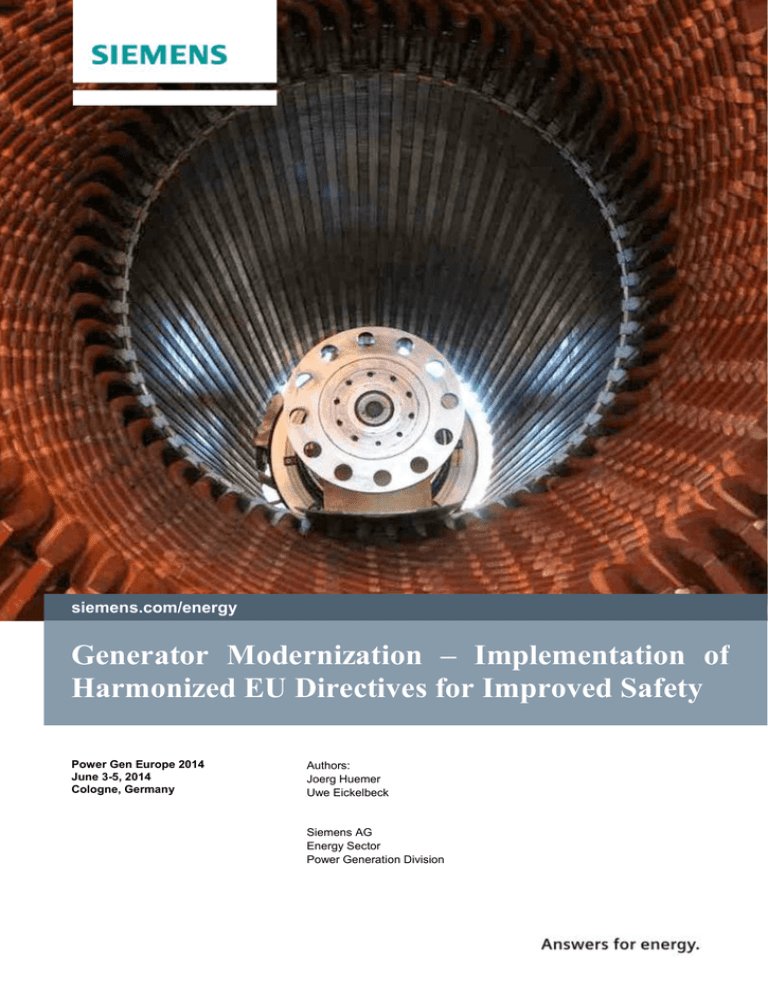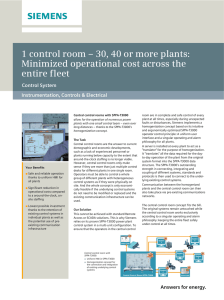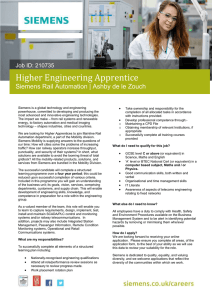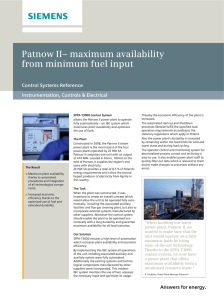
siemens.com/energy
Generator Modernization – Implementation of
Harmonized EU Directives for Improved Safety
Power Gen Europe 2014
June 3-5, 2014
Cologne, Germany
Authors:
Joerg Huemer
Uwe Eickelbeck
Siemens AG
Energy Sector
Power Generation Division
Table of Contents
1
Abstract .................................................................................................................. 3
2
Background ............................................................................................................ 3
3
Zone Classification ................................................................................................. 4
4
Application of ATEX Directives (Examples) ........................................................ 6
4.1
Single Tower Gas Dryer ......................................................................................... 7
4.2
Liquid Level Detector Rack ................................................................................... 8
5
Modernization Measures ........................................................................................ 9
6
Summary .............................................................................................................. 10
7
References ............................................................................................................ 10
8
Disclaimer ............................................................................................................ 11
AL: N; ECCN: N
Unrestricted © Siemens AG 2014. All rights reserved.
Page 2 of 12
1 Abstract
Hydrogen is an ideal generator coolant for medium and large-sized turbo generators, having
good heat transfer characteristics and low windage losses. But to maintain these advantages,
the hydrogen must be handled carefully, with the necessary attention to safety measures.
In this respect, the hydrogen filling and venting process of the generator as well as proper
operation play a very important role in the prevention and handling of possible explosive
atmospheres.
It is mandatory to implement the requirements of international standards such as ATEX
Directive 94/9/EC [1] and IEC60034-3 [2] to ensure safe and reliable operation of the power
plant. In the context of legacy plants, it is necessary to define which measures can be
implemented to meet the latest safety requirements.
The technical and legal background, boundaries and implementation strategies will be
presented as well as typical examples from executed projects.
2 Background
The hydrogen gas used for cooling certain generator designs can mix with air to form an
explosive gas mixture. Such mixtures can occur when the hydrogen gas is deliberately vented
to the atmosphere via the turbine building roof or if hydrogen escapes uncontrolled through
leaks (e.g. at breakable connections). Special precautions must therefore be taken to comply
with valid explosion protection requirements to prevent a potential explosion in hazardous
areas.
Generators, exciter and auxiliaries (hydrogen supply, waste gas system, seal oil system and
stator water system) are in their majority installed in machine houses.
AL: N; ECCN: N
Unrestricted © Siemens AG 2014. All rights reserved.
Page 3 of 12
Liquid
Level
Detector
Rack
Gas Dryer
Fig. 1: Overview of generator auxiliaries including gas dryer and liquid level detector rack
The generator area including its auxiliary systems is divided into different explosion
protection zones resulting in different requirements for transmitters, actuators, and their
electrical wiring.
The areas outside these zones are not subject to explosion protection requirements.
3 Zone Classification
Explosion hazard areas are divided into zones to simplify the selection of suitable components
and to facilitate the correct design of electrical installations.
For hydrogen and other gases, the applicable zones are:
■
Zone 0
Place in which an explosive atmosphere consisting of a mixture with air
of flammable substances in the form of gas, vapor or mist is present
continuously or for long periods or frequently. (not applicable to the
generator area)
■
Zone 1
Place in which an explosive atmosphere consisting of a mixture with
air of flammable substances in the form of gas, vapor or mist is likely
AL: N; ECCN: N
Unrestricted © Siemens AG 2014. All rights reserved.
Page 4 of 12
to occur occasionally in normal operation. (e.g. H2 bottle rack, zone
diameter 0.5 m plus 0.5 m for zone 2)
■
Zone 2
Place in which an explosive atmosphere consisting of a mixture with
air of flammable substances in the form of gas, vapor or mist is not
likely to occur in normal operation but, if it does occur, will persist for
a short period only.
■
No zone
In zones 0 and 1, the only electrical devices that may be used are those which are explicitly
approved for that zone and for which an ATEX certificate has been issued. In zone 2,
electrical devices may be used that comply with the standard safety requirements and for
which at least a supplier's declaration is present.
Transmitters approved for a more restricted zone may also be installed in a less restricted
zone.
The calculation of the leak jet extension of 0.5 m is based on IEC / DIN EN 60034-3 [2]:
• if the uncontrolled losses exceed 18 m3 NTP within 24 hours, action shall be taken to
reduce those losses
• the calculation was based on the "worst-case" scenario of a leak of 18 m3 NTP within
24 hours at one single point of release
Controlled and uncontrolled losses can be defined as follows:
Controlled losses are those volumetric flows which are used e.g. for measurements and which
are subsequently vented to the environs via the roof. Uncontrolled hydrogen losses include
those losses which are incurred as a result of small leaks in various locations, and also include
those losses which are incurred when hydrogen diffuses to the outside of the generator
through seals, or, in the case of water-cooled generators, to the stator water cooling system
through Teflon hoses and bolted joints.
The following figure illustrates the extent of the explosion zone depending on the volume
flow derived from the IEC limit of 18 m³ NTP per 24 hours.
AL: N; ECCN: N
Unrestricted © Siemens AG 2014. All rights reserved.
Page 5 of 12
Fig. 2: Classification of hydrogen reactions based on reaction velocity [3]
4 Application of ATEX Directives (Examples)
In general there are different strategies that need to be followed in order to ensure human
safety during operation of systems where hydrogen occurs or at least could occur. These
targets in accordance with the ATEX directives are:
■
to prevent the formation of an explosive atmosphere
■
to prevent the ignition of an explosive atmosphere
■
to minimize the consequences of an explosion to a harmless degree
The first two targets can be addressed by ATEX-compliant design of the respective systems,
while as regards the third target provisions need to be made to ensure that, for example,
operating staff is made aware of hazardous areas (e.g. by markings on the ground or labelling
of affected systems). Here the focus will be on compliant design.
AL: N; ECCN: N
Unrestricted © Siemens AG 2014. All rights reserved.
Page 6 of 12
4.1
Single Tower Gas Dryer
In order to keep humidity in the generator low, the generator gas dryer is continuously passed
through with the hydrogen from the generator during operation. The dried hydrogen is fed
back to the generator. This situation leads to the assumption that the definition for ATEX
zone 2 is valid at all detachable connections. Fig. 3 shows an example of the gas dryer as well
as the explosion zone drawing showing the superjacent explosion zone clouds which together
form the overall explosion zone.
Fig. 3: Example of ATEX zoning: generator single tower gas dryer
All electrical components located within the overall explosion zone must be of explosionproof design and certified accordingly. Unlike components located in explosion zone 1, in
zone 2, electrical devices may be used that comply with standard safety requirements and for
which at least a supplier's declaration is present. Nevertheless, the challenge should be not to
place electrical components within the overall zone at all, since most ATEX-certified
components involve added cost depending on which kind of equipment is used.
AL: N; ECCN: N
Unrestricted © Siemens AG 2014. All rights reserved.
Page 7 of 12
4.2
Liquid Level Detector Rack
The liquid level detectors, located on a wall-mounted rack, detect all kinds of liquids present
inside the generator. These liquids are usually oil or water. Fig. 4 shows quite a simple
version for use with hydrogen-cooled generators. Generators with a water-cooled stator
require a more sophisticated system, since water poses a much higher risk to the operability of
the generator.
Fig. 4: Example of ATEX zoning: liquid level detector rack
Since it is sometimes necessary to open the isolation valves of the liquid detectors even when
the generator is operating, a small amount of hydrogen may leak at these points.
Consequently, the outlets of the liquid level detectors form an explosion zone 1. Fig. 4 shows
how zone 1 and zone 2 overlap in this configuration. The detectors themselves, being located
in zone 1, must be certified accordingly.
AL: N; ECCN: N
Unrestricted © Siemens AG 2014. All rights reserved.
Page 8 of 12
5 Modernization Measures
As the auxiliaries can have a relatively long service life, they may comprise technology that is
either no longer state of the art or may not be compatible with current codes and standards
such as the ATEX Directive 94/9/EC [1] and IEC60034-3 [2].
Amendments made to the explosion protection codes and standards in the meantime, as well
as technical progress, may make it advisable to modernize older generator auxiliaries.
In addition, operation of older technology and material can lead to increased maintenance or
repair costs and may result in delays for procuring spare parts.
The ATEX conformity of operating plants must be checked and if necessary established.
Responsibility for implementing explosion protection measures in all operating plants rests
with their operators.
Modernization and establishing ATEX conformity may make it necessary to replace entire
generator auxiliary systems which are not in compliance with the latest explosion protection
requirements by new explosion-protected systems. Thanks to the modular approach of
Siemens generator auxiliary systems, substituting individual components is no problem.
Although it is possible to recondition entire skids and refurbish the legacy instrumentation
circuits (sensors, wiring, etc.), it may be more expedient to replace complete skids.
Substituting whole systems provides the following benefits:
■
current state of the art & explosion-protected design
■
higher availability
■
reduced risk of potential personal injury or damage in the plant
■
compact design delivered ready to connect
■
shorter modification times
■
easier procurement of spare parts
AL: N; ECCN: N
Unrestricted © Siemens AG 2014. All rights reserved.
Page 9 of 12
6 Summary
ATEX regulations apply to nearly all assembly groups of the hydrogen and hydrogen/watercooled generator, and therefore the ATEX zoning has to be clearly defined when designing
generator instrumentation and auxiliary systems. In this respect ATEX zoning for the
different components is very helpful, providing visual information about how further design
improvement is possible. The zone extension of 0.5 m derives from the theoretical approach
of calculating the leak jet range. Boundary conditions for the calculation are taken from the
“worst case scenario” (18 m³ NTP uncontrolled hydrogen losses within 24 hours) as described
in IEC / DIN 60034-3 [2].
SIEMENS is able to deliver modularized generator auxiliary systems which are in compliance
with harmonized EU directives, e.g. ATEX, including plant-specific planning, installation and
commissioning. Substituting completely modularized auxiliary skids can, on the basis of a
holistic safety assessment, be a better and simpler solution than replacing individual
components.
7 References
[1] ATEX Directive 94/9/EC of the European Parliament and the Council, 23 March 94
[2] IEC 60034-3: Rotating electrical machines – Part 3: Specific requirements for cylindrical
rotor synchronous machines Fifth Edition 2005-02
[3] Bildung und Ausbreitung zündfähiger Wasserstoff-Luft Gemische aus postulierten
Leckagen im Generatorbereich, Dr. Tilman Diesselhorst, Peter Schönfeld, Dr. Klaus
Friedrich Freudenstein, VGB PowerTech e.V., 12/2006
AL: N; ECCN: N
Unrestricted © Siemens AG 2014. All rights reserved.
Page 10 of 12
8 Disclaimer
These documents contain forward-looking statements and information – that is, statements
related to future, not past, events. These statements may be identified either orally or in
writing by words as “expects”, “anticipates”, “intends”, “plans”, “believes”, “seeks”,
“estimates”, “will” or words of similar meaning. Such statements are based on our current
expectations and certain assumptions, and are, therefore, subject to certain risks and
uncertainties. A variety of factors, many of which are beyond Siemens’ control, affect its
operations, performance, business strategy and results and could cause the actual results,
performance or achievements of Siemens worldwide to be materially different from any
future results, performance or achievements that may be expressed or implied by such
forward-looking statements. For us, particular uncertainties arise, among others, from changes
in general economic and business conditions, changes in currency exchange rates and interest
rates, introduction of competing products or technologies by other companies, lack of
acceptance of new products or services by customers targeted by Siemens worldwide,
changes in business strategy and various other factors. More detailed information about
certain of these factors is contained in Siemens’ filings with the SEC, which are available on
the Siemens website, www.siemens.com and on the SEC’s website, www.sec.gov. Should one
or more of these risks or uncertainties materialize, or should underlying assumptions prove
incorrect, actual results may vary materially from those described in the relevant forwardlooking statement as anticipated, believed, estimated, expected, intended, planned or
projected. Siemens does not intend or assume any obligation to update or revise these
forward-looking statements in light of developments which differ from those anticipated.
Trademarks mentioned in these documents are the property of Siemens AG, its affiliates or
their respective owners.
AL: N; ECCN: N
Unrestricted © Siemens AG 2014. All rights reserved.
Page 11 of 12
Published by and copyright © 2014:
Siemens AG
Energy Sector
Freyeslebenstrasse 1
91058 Erlangen, Germany
Siemens Energy, Inc.
4400 Alafaya Trail
Orlando, FL 32826-2399, USA
For more information, please contact
our Customer Support Center.
Phone: +49 180/524 70 00
Fax:
+49 180/524 24 71
(Charges depending on provider)
E-mail: support.energy@siemens.com
All rights reserved.
Trademarks mentioned in this document are
the property of Siemens AG, its affiliates,
or their respective owners.
AL: N; ECCN: N
Subject to change without prior notice.
The information in this document contains
general descriptions of the technical options
available, which may not apply in all cases.
The required technical options should therefore
be specified in the contract..
Unrestricted © Siemens AG 2014. All rights reserved.
Page 12 of 12









